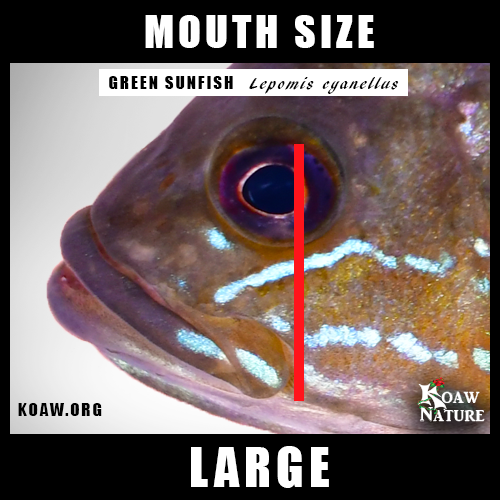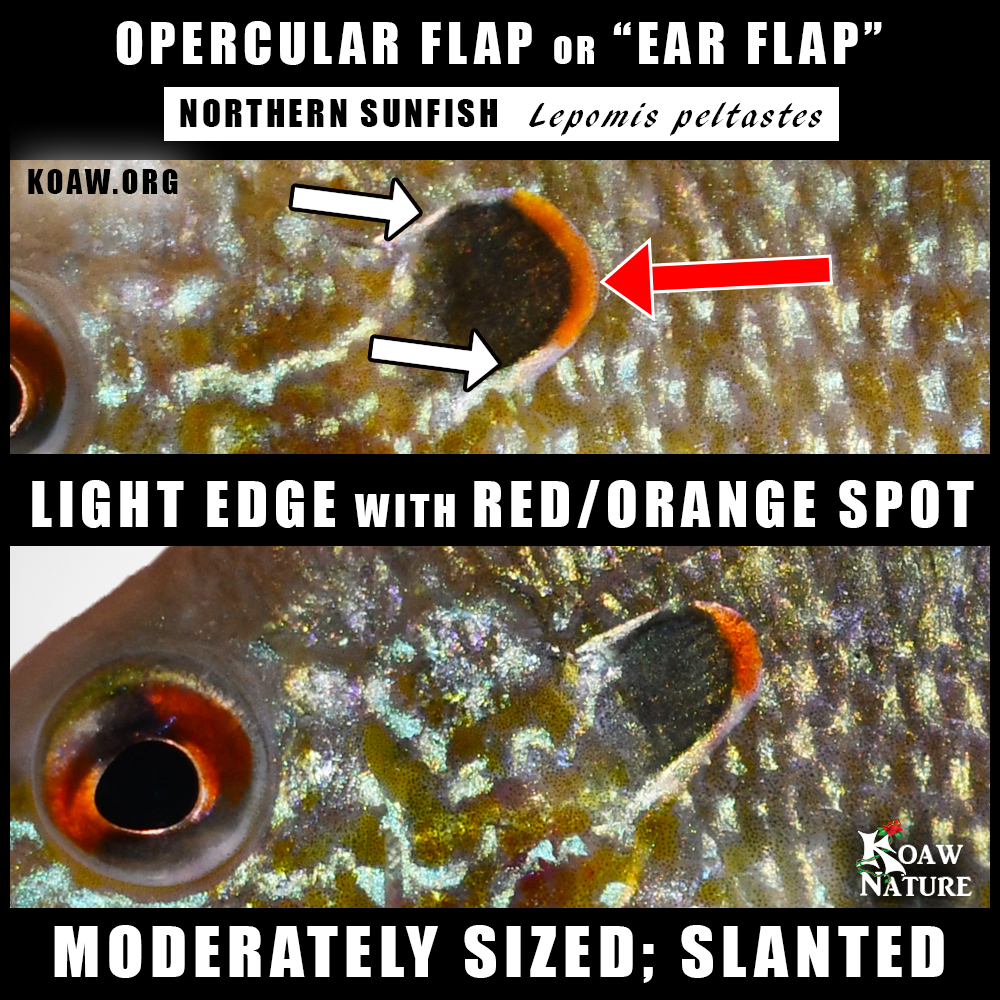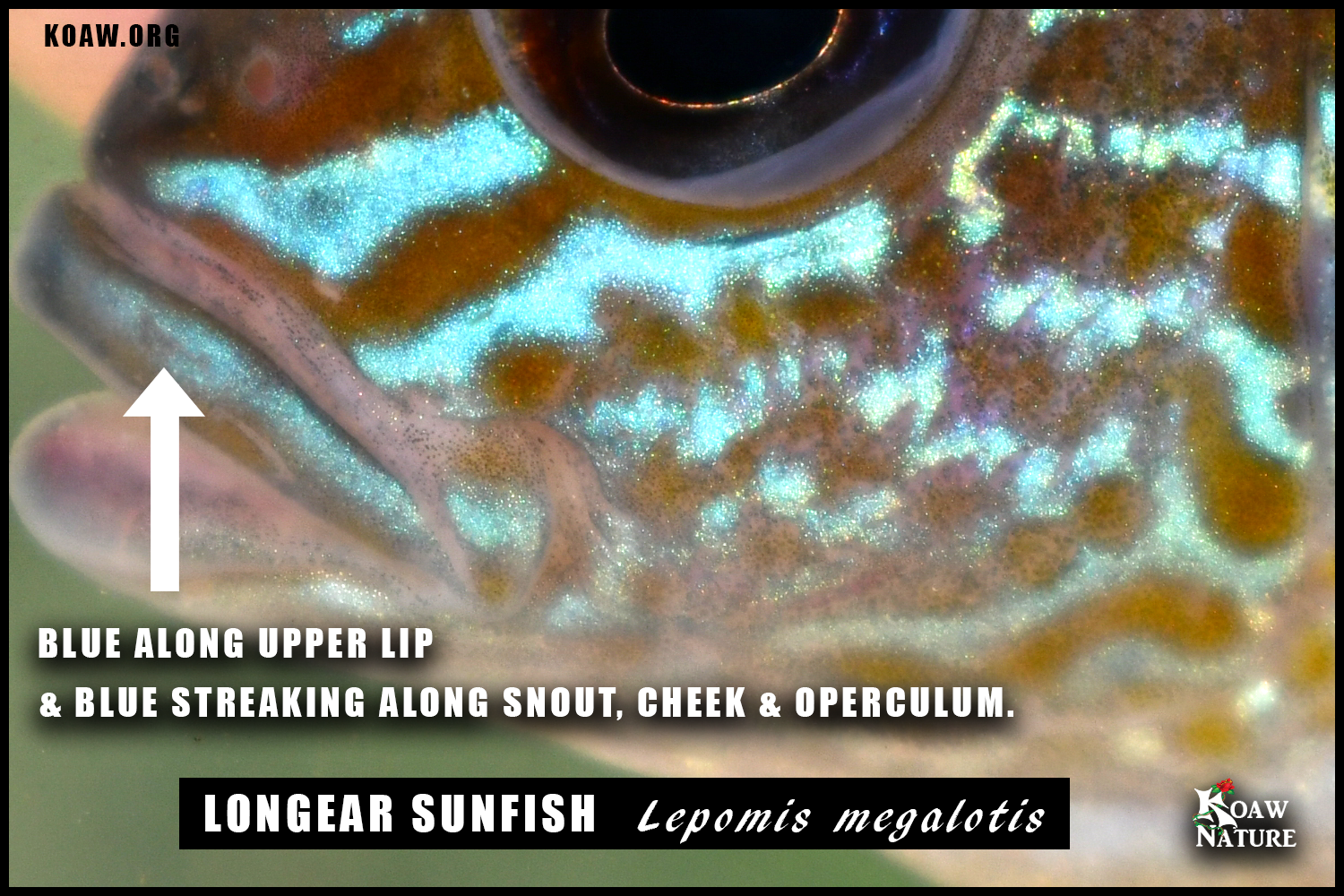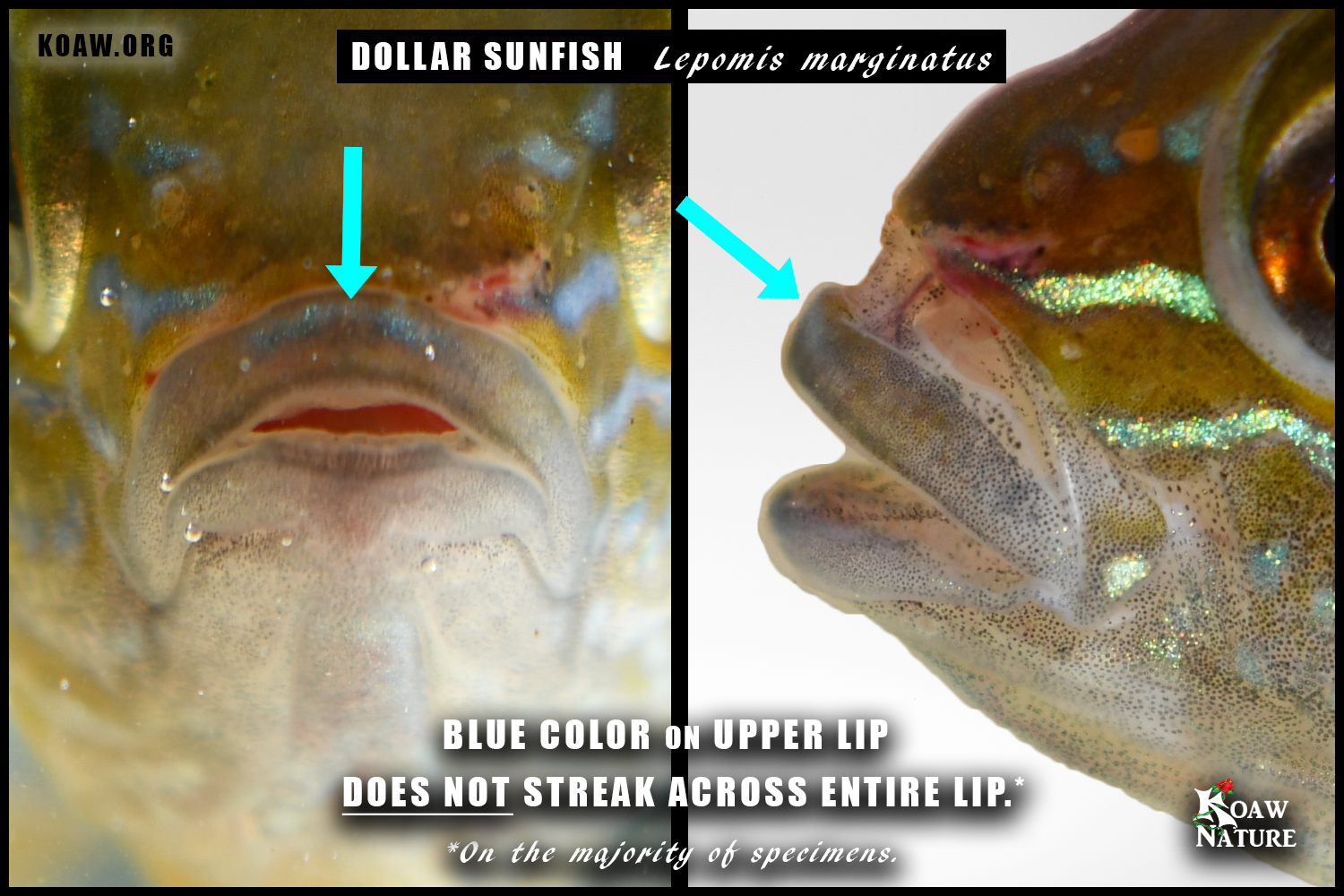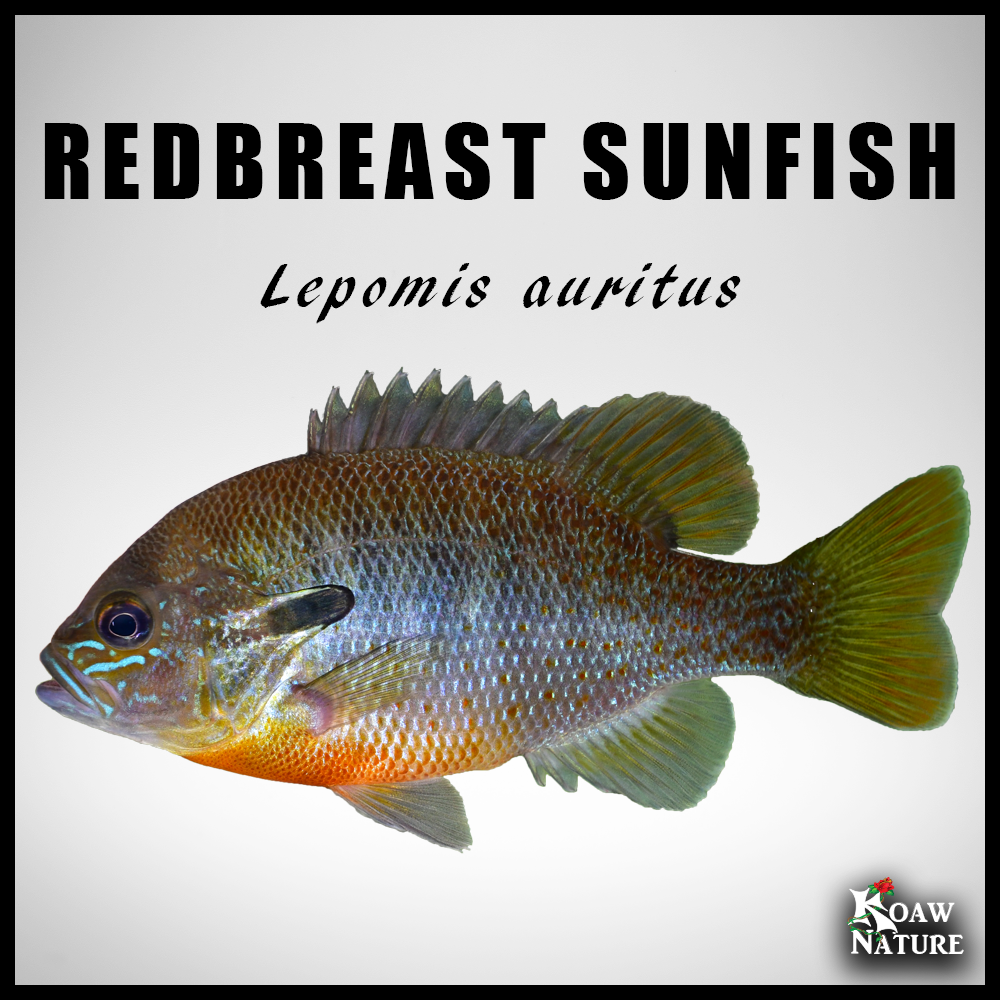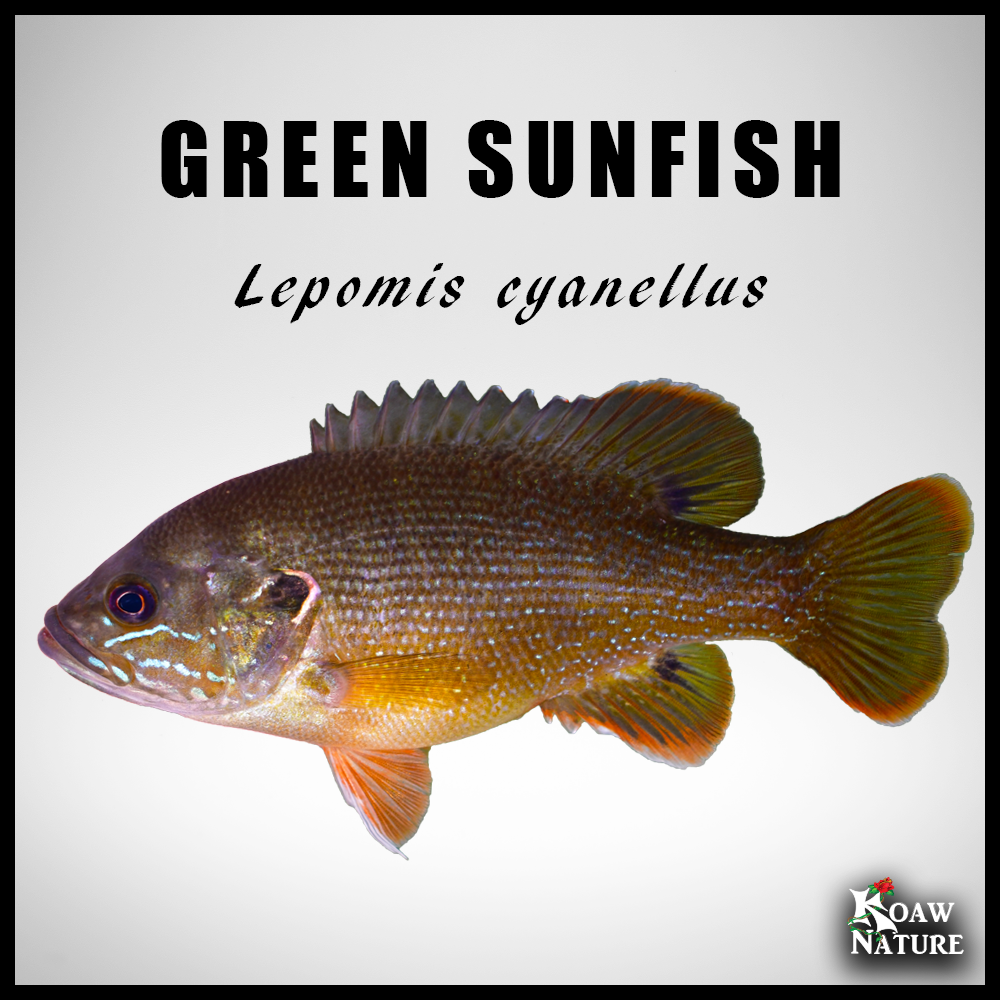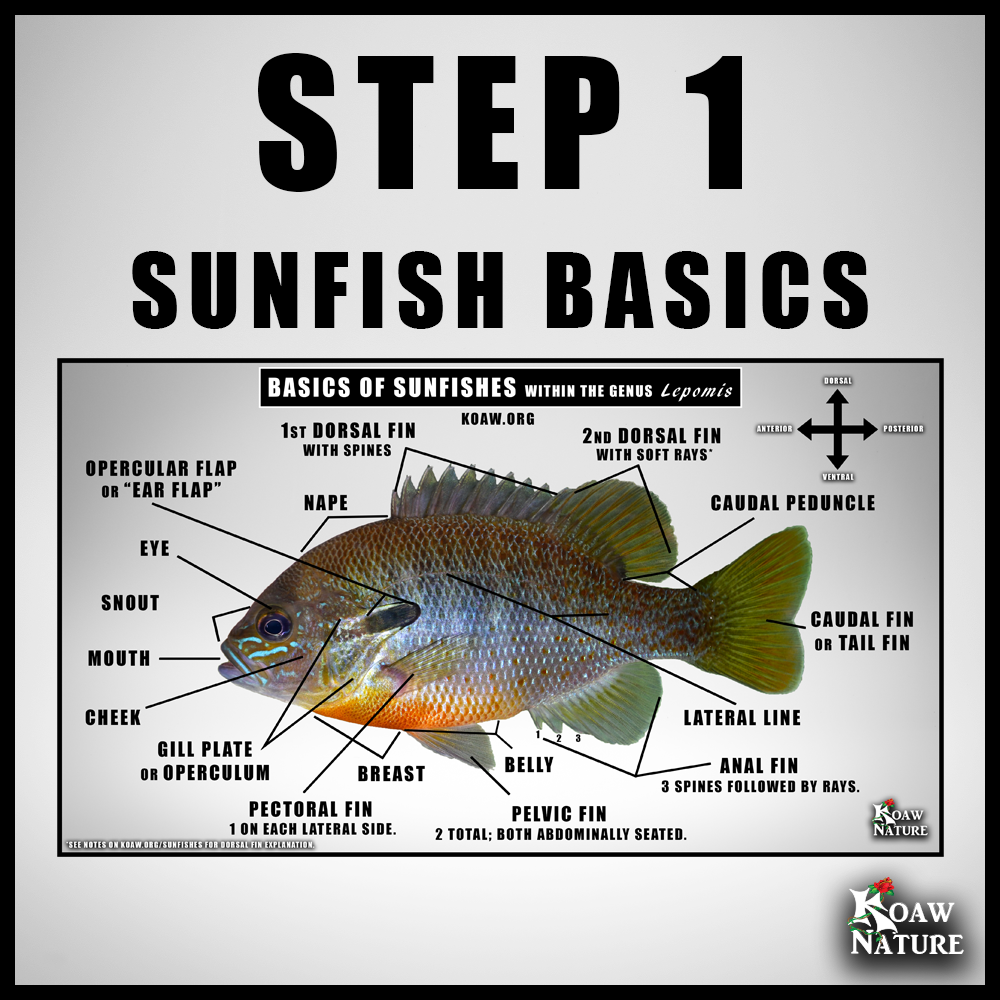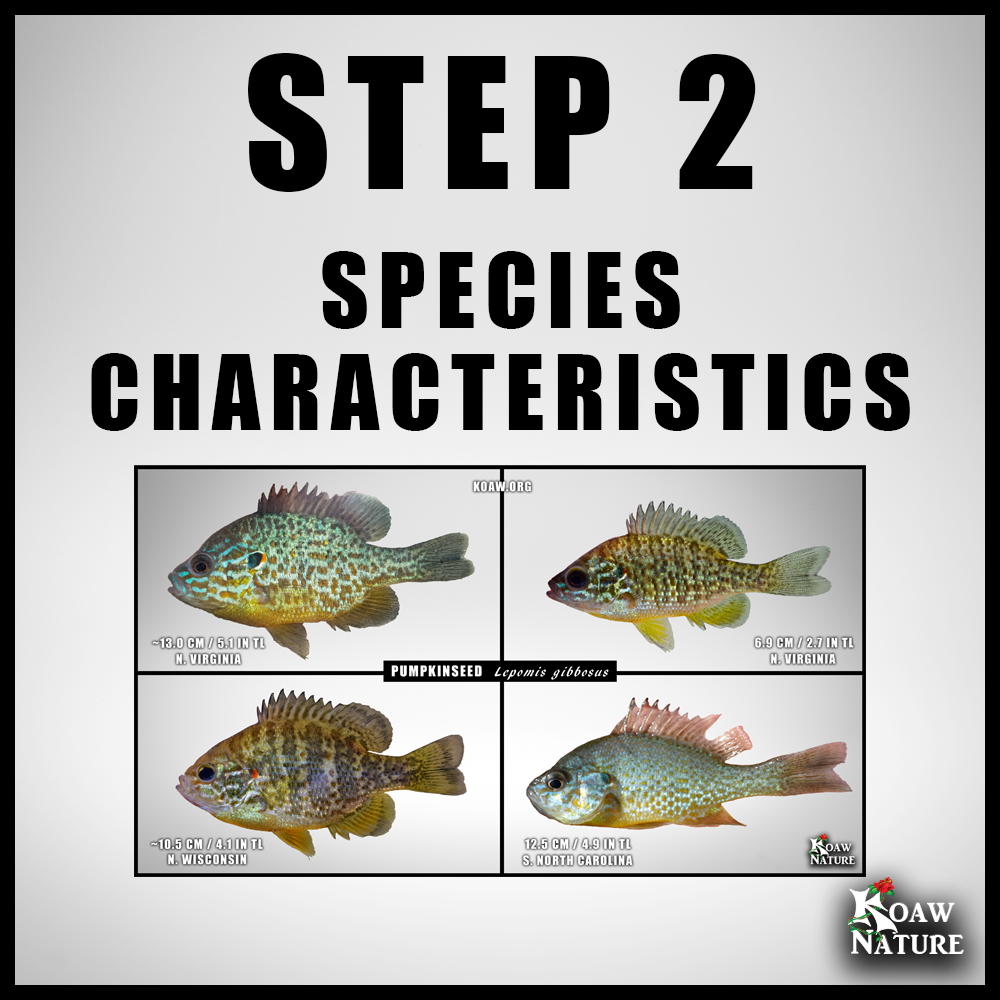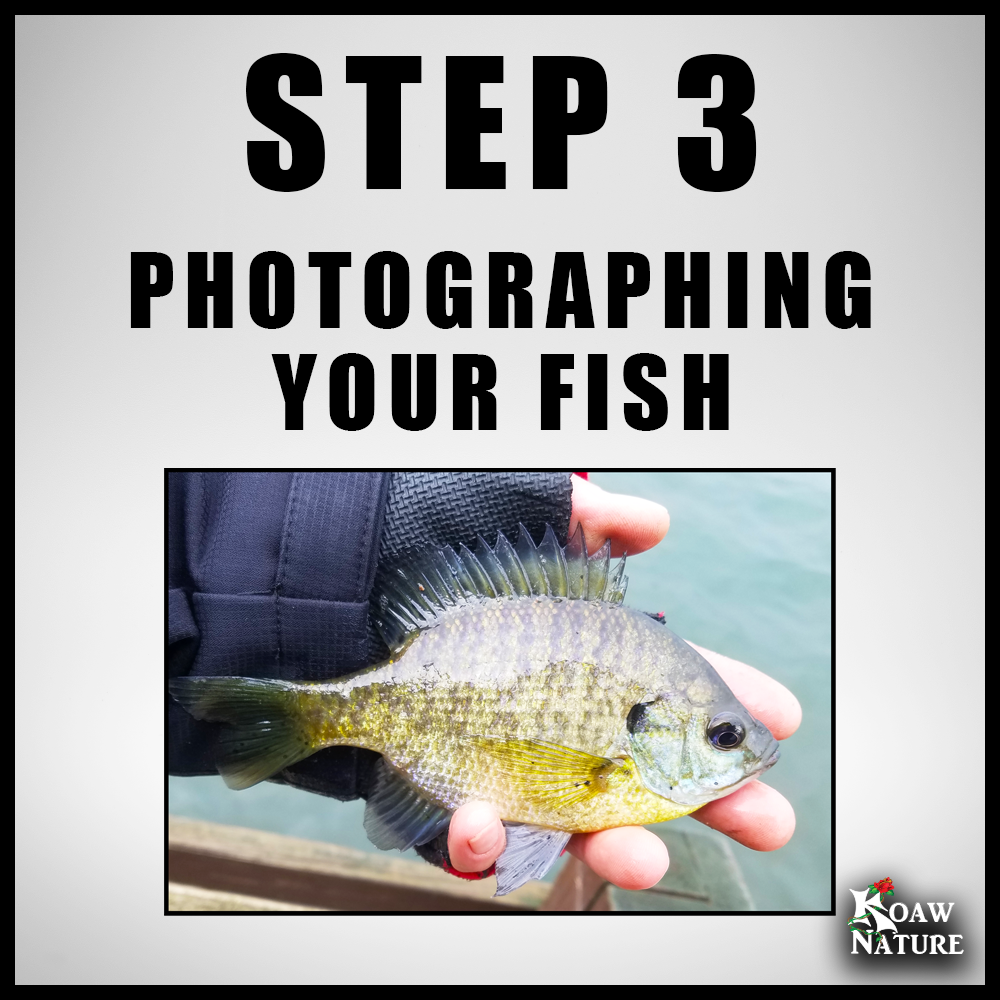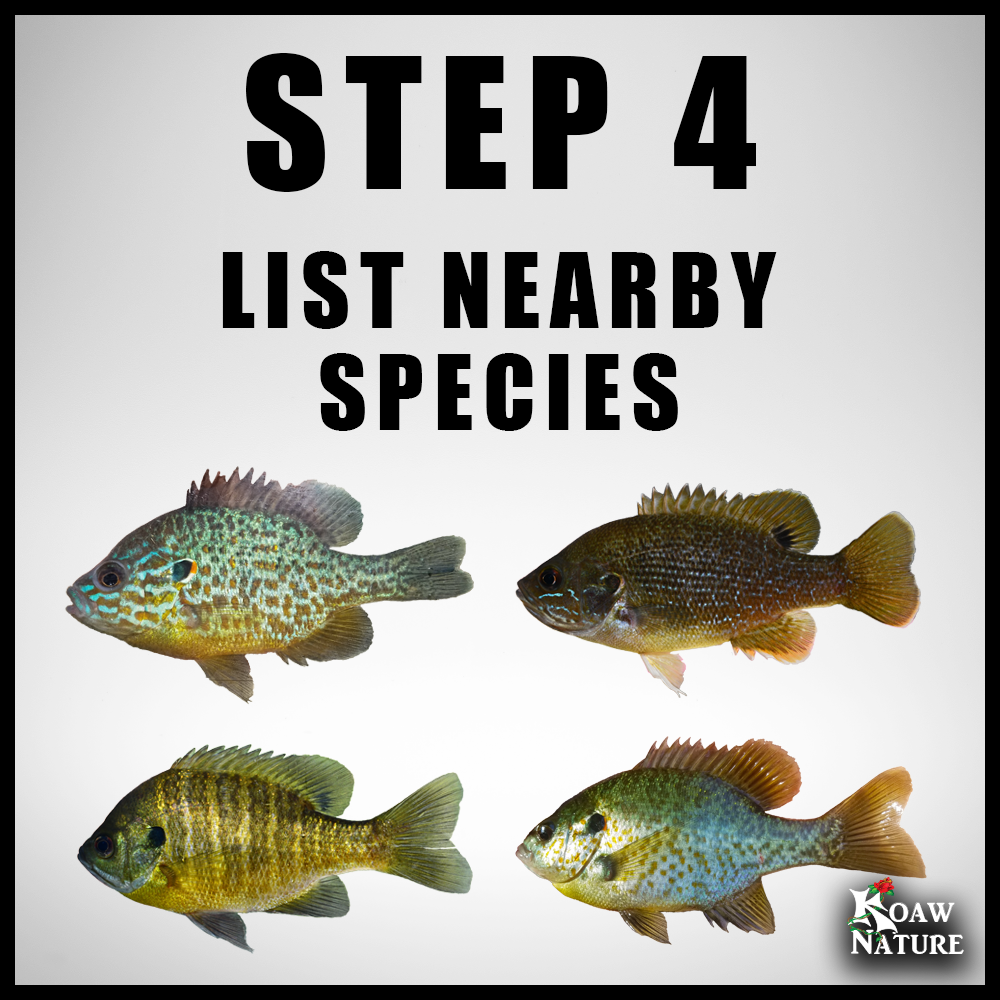By Koaw - November - 2020 (Updated March - 2023)
STEP 5: So you’ve captured your fish, you’ve taken the appropriate photographs (from STEP 3) and you have a good understanding of basic sunfish anatomy (from STEP 1 & STEP 2). You should also have a tentative list of sunfishes in the area you caught your fish (from STEP 4). It’s time for the final analysis using ‘Koaw’s Quick Cheat Sheet’!
Firstly, let’s make sure you have a lepomid. Your fish should have come from freshwater, not saltwater; although sometimes lepomids are found in brackish water. The following features should be there:
Three anal spines. (It’s extremely rare for a lepomid to not have three anal spines.)
A conspicuous opercular flap on the back of the gill plate. (Sometimes this may be faded on juveniles.)
An indented, or shallowly forked, caudal fin. The caudal fin, or tail fin, will not be rounded if it is a fish within the genus Lepomis. (If your fish has three anal spines, a mostly black opercular flap and a rounded caudal fin then it is likely a member of the genus Enneacanthus.)
Click here for some Lepomid vs. other genera comparison graphics.
Below you will find what I have affectionately named ‘Koaw’s Cheat Sheet for Lepomid Identification’ that will offer you quick-analysis tools for comparing against your specimen in question. This ID key assumes you have a pure or mostly pure specimen; if, after browsing this information, you believe you have a hybrid then please check out my supplementary hybrid identification pages.
BROWSING TIP: The common names of species are linked to their respective individual pages here on Koaw.org while the images, if clicked on, will become larger for closer examination.
KOAW’S CHEAT SHEET FOR LEPOMID IDENTIFICATION
FEATURES DISCUSSED BELOW | 1. PECTORAL FIN | 2. MOUTH/JAW SIZE | 3. OPERCULAR FLAP | 4. EYE | 5. UPPER LIP | 6. SPOTS ON BODY | 7. DORSAL FIN BLOTCH | 8. GILL RAKERS |
PECTORAL FIN
LONG & POINTED PECTORAL FIN: If the pectoral fin is pointy and long, extending past the front of the eye if you were to bend it forward then you likely have a bluegill (L. macrochirus), redear sunfish (L. microlophus) or a pumpkinseed (L. gibbosus). The redear sunfish typically has the longest pectoral fin of all lepomids.
VERY SHORT & ROUND PECTORAL FIN: If the pectoral fin is roundly and very short, not even extending to the posterior edge of the eye if you were to bend it forward then you likely have a green sunfish (L. cyanellus), or less often, a warmouth (L. gulosus).
MODERATELY-SIZED PECTORAL FIN & 11-12 PECTORAL RAYS: If the pectoral fin is moderately-sized, extending under the pupil if bent forward AND has 12 or 11 pectoral rays, then you likely have a dollar sunfish (L. marginatus) or a northern sunfish (L. peltastes).
2. MOUTH/JAW SIZE
VERY LARGE/LARGE MOUTH: If the posterior edge of the maxillary aligns past the middle of the pupil or farther then you have a warmouth (L. gulosus) or a green sunfish (L. cyanellus). The mouths on these two species are so large that ‘lipping’ the fish is no problem, like you would lip a black bass.
FAIRLY LARGE MOUTH: If the posterior edge of the maxillary aligns to or just past the anterior edge of the pupil then you likely have an orangespotted sunfish (L. humilis), a redbreast sunfish (L. auritus) or a bantam sunfish (L. symmetricus).
SMALL MOUTH: If you have a fish with a small mouth, where the posterior edge of the maxillary does not extend past the anterior edge of the eye, or is very near that edge, then you likely have a northern sunfish (L. peltastes), bluegill (L. macrochirus), redear sunfish (L. microlophus) or pumpkinseed (L. gibbosus).
3. OPERCULAR FLAP
The following guidelines for opercular flaps best apply to mature specimens.
ALL BLACK: If you have a sunfish with an all-black opercular flap and no color around the edging then you likely have a bluegill (L. macrochirus). Keep in mind that the bluegill may have some bluish/green iridescence on the black portion of the opercular flap that only appears when the light hits it from a certain angle from your perspective.
BLACK BACK + COLOR EDGING: If you have a sunfish with a black posterior edge on the opercular flap that has some color dorsally and/or ventrally along the flap then you likely have a redbreast sunfish (L. auritus), a spotted sunfish (L. punctatus), or a redspotted sunfish (L. miniatus).
LONG EAR FLAP: If you have a sunfish with an ear flap obviously longer than the length of the eye with some form of colored edging (not necessarily around the entire ear flap) then you likely have a longear sunfish (L. megalotis) or a redbreast sunfish (L. auritus).
SOLID RED SPOT + PALE EDGING: If you have a sunfish with a bright, SOLID red spot on the posterior edge of the opercular flap that is enclosed BOTH dorsally and ventrally by a whitish edging then you likely have a northern sunfish (L. peltastes), a pumpkinseed (L. gibbosus) or a redear sunfish (L. microlophus).
Note: The warmouth (L. gulosus) and green sunfish (L. cyanellus) will have red on the opercular flap but the color is often diluted, and/or blended with purple and orange. Also, the warmouth rarely has any pale edging on the dorsal edging on the ear flap.
MOSTLY PALE EDGING: If you have a sunfish that has a very pale edging, with or without some other faded colors, around the entire edging (dorsal, posterior and ventral) of the opercular flap then you likely have an orangespotted sunfish (L. humilis), a longear sunfish (L. megalotis), a bantam sunfish (L. symmetricus) or a dollar sunfish (L. marginatus).
4. EYE
BRIGHT BLUE ‘BOWL’: If you have a sunfish with a bright blue iridescent ‘bowl’ in the ventral part of the eye then you have either a spotted sunfish (L. punctatus) or a redspotted sunfish (L. miniatus).
5. UPPER LIP
BLUE ACROSS ENTIRE UPPER LIP: If you have a fish with an upper lip that has a bluish streaking across the entirety then you likely have a longear sunfish (L. megalotis), a redbreast sunfish (L. auritus), a northern sunfish (L. peltastes) and, at times, a pumpkinseed (L. gibbosus).
BROKEN BLUE ON UPPER LIP: If you have a fish with broken bluish streaking across the upper lip then you likely have a dollar sunfish (L. marginatus), a green sunfish (L. cyanellus) and, at times, a pumpkinseed (L. gibbosus).
6. SPOTS ON THE BODY
MANY RED OR ORANGE SPOTS: If you have a sunfish with many red or orange spots on the side of the body then you likely have an orangespotted sunfish (L. humilis), a redspotted sunfish (L. miniatus), a redbreast sunfish (L. auritus), or a pumpkinseed (L. gibbosus). On occasion mature warmouth (L. gulosus) have conspicuous red or orange spots on the body, more likely on breeding males and more often seen in southern states like Texas & Florida. Some longear sunfish populations (L. megalotis) have orange spots encircled in blue, especially seen in Texas.
BLACK SPOTS: If you have a sunfish with many black spots along the side of the body forming irregular horizontal rows then you likely have a spotted sunfish (L. punctatus). Sometimes the redspotted sunfish has black spots; please see the individual species page to learn more. On male bluegill (L. macrochirus) in breeding colors, often there are dark spots along the nape, and on occasion, along the side of the body that are scattered. The bantam sunfish (L. symmetricus) often has dark, coffee-colored spots along the body; large adults may have very discrete dark spots on the body. Female orangespotted sunfish (L. humilis) in breeding colors will have dark brown spots that may appear black. Dollar sunfish (L. marginatus) in the most southeastern part of the range (e.g. Florida) may have black spots on the upper body.
BLUE SPOTS: If you have a fish with blue spotting along the body then you likely have a longear sunfish (L. megalotis), a northern sunfish (L. peltastes), a green sunfish (L. cyanellus) or a dollar sunfish (L. marginatus).
7. DARK DORSAL FIN BLOTCH
DARK BLOTCH ON SECOND DORSAL FIN: If you have a specimen with a dark blotch on the posterior end of the 2d dorsal fin then you either have a bluegill (L. macrochirus), a green sunfish (L. cyanellus) or a bantam sunfish (L. symmetricus).
Note: The redbreast sunfish (L. auritus) often has darker coloration running along the proximal (near the body) portion of the 2d dorsal fin that may getter darker posteriorly. Texas longear sunfish (L. megalotis) may have a faint dark blotch, rarely pronounced.
8. GILL RAKERS
Analyze the rakers as best you can by finding the longest raker visible on the 1st gill arch. The bantam sunfish has some of the longest rakers, usually 7-9 times longer than wide.
Gill raker sizes are not just variable between species but also within different populations of the same species. I have provided photos of the most commonly encountered sizes for each species.
LONG AND THIN RAKERS: The bantam sunfish (L. symmetricus), warmouth (L. gulosus), bluegill (L. macrochirus), green sunfish (L. cyanellus), orangespotted sunfish (L. humilis), spotted sunfish (L. punctatus) and the redspotted sunfish (L. miniatus) have long and thin rakers.
MEDIUM LONG AND THICK RAKERS: The redbreast sunfish (L. auritus) has been shown to have quite variable lengths on the rakers. The thickness will be greater than any of the species above though the length may be as long on similar-sized specimens.
SHORT & THICK RAKERS: The redear sunfish (L. microlophus), longear sunfish (L. megalotis), pumpkinseed (L. gibbosus), northern sunfish (L. peltastes) and dollar sunfish (L. marginatus) have very short and thick rakers. The dollar sunfish by far had the knobbiest rakers compared to any other species I analyzed for this project.
TRAITS ONLY FOUND ON ONE SPECIES
COLORATIONS/MARKINGS
3+ DARK EYE LINES
If you have a lepomid with three or more dark, radiating lines coming from the back of the eye then you have a warmouth (L. gulosus).
RED BLOTCH ON 2D DORSAL FIN
If you have a sunfish with a red blotch on the posterior base of the 2d dorsal fin then you have a male warmouth (L. gulosus) in breeding colors.
BLUE + RED SPOTS
If you have a specimen with bluish green spots on the black portion of the opercular flap AND reddish spots along the lateral line then you likely have a dollar sunfish (L. marginatus).
2. LATERAL LINE
BROKEN LATERAL LINE
If you have a sunfish with a broken lateral line then you probably have a bantam sunfish (L. symmetricus) though a northern sunfish (L. peltastes) may have a broken lateral line about 25% of the time.
Instances of a broken lateral line are possible on other lepomids, though seemingly rarer.
3. TEETH ON TONGUE
TEETH ON TONGUE
If you have a lepomid with teeth on the tongue then you have a warmouth (L. gulosus).
Very rarely is there a small patch of teeth on the tongue of the green sunfish (L. cyanellus).
Still not sure what your species is? Or maybe you want to contribute your photos to science!? Or both? Then have someone else take a look in Step 6!








